2017 江苏南京航空航天大学英语考研真题
Vocabulary and Structure (20 points)
Directions: There are 20 incomplete sentences in this part. For each sentence there
are fourchoices marked A., B., C. and D. Choose ONE answer that best completes the
sentence.
1. She would like to have a talk with you _____ your convenience.
A. in B. at C. for D. with
2. Such ____the case, there are no grounds to justify your complaints.
A. was B. is C. is being D. being
3. The train____ at the present speed until it reaches the next city at about seven
o’clock this evening.
A. will be going B. went C. would go D. went
4. If English is not our first language you can often be puzzled by ways of expression
that the native speaker of
English does not even have to _____.
A. think out B. think about C. think over D. think for
5. That battle is of great significance when viewed in the ____ of the progress of
the war.
A. view B. opinion C. perspective D. idea
6. As he was blamed for damage he hadn‟t caused, indignation ____ up in him.
A. surged B. appeared C. rose D. soared
7. If the fire alarm is sounded, all students are requested to _____ in the courtyard.
A. converge B. assemble C. crowd D. accumulate
8. If Peter wins tomorrow, he _____ thirty races in the past four years.
A. will win B. has won C. would have won D. will have won
9. Petrol is manufactured from the ____ oil we take out of the ground.
A. rough B. raw C. crude D. tough
10. The size of the audience, ____ we had expected, was well over one thousand.
A. whom B. as C. who D. that
11. Our house is about a mile from the station and there are not many houses________.
A. far apart B. among them C. in between D. from each other
12. I don‟t think that this question is subordinate ________the main aim of our
company.
A. with B. on C. for D. to
13. In American universities, classes are often arranged in more flexible _____ and
many jobs on campus are reserved for students.
A. scales B. ranks C. grades D. patterns
14. To understand the situation completely requires more thought than ____ thus far.
A. has been given B. was given C. being given D. has given
15. It is requested that an applicant whose undergraduate work is done at another
institution ____ two copies of undergraduate transcripts and degrees directly to
the dean of the graduate school.
A. must send B. are to send C. send D. need send
�
16. This rock has to be ____ in order to build a road.
A. blasted B. explored C. hired D. maintained
17. When they returned to the river, they found that the boat had _______ away.
A. framed B. frosted C. frowned D. floated
18. The English proverb “____ the rod and spoil the child” means that if you keep
from punishing the child,you will spoil its character.
A. rule B. spare C. clap D. rug
19. After people have learned that magnets attract things, centuries passed ____
they took note of the fact that magnets sometimes also repel things.
A. before B. until C. after D. since
20. In that country, students will be _____ admittance to their classroom if they
are not properly dressed.
A. declined B. deprived C. denied D. deserted
II. Reading Comprehension (30 points)
Directions: There are 4 passages in this part. For each of them there are four choices
marked A.,B., C. and D. You should decide on the best choice.
Passage 1
Testing has replaced teaching in most public schools. My own children‟s school week
is framed by pretests, drills, tests, and retests. They know that the best way to
read a textbook is to look at the questions at the end of the chapter and then skim
the text for the answers. I believe that my daughter Erica, who getsexcellent marks,
has never read a chapter of any of her school textbooks all the way through. And
teachers are often heard to state proudly and openly that they teach to the mandated
state test.
Teaching to the test is a curious phenomenon. Instead of deciding what skills
students ought to learn,helping students learn them, and then using some sensible
methods of assessment to discover whether students have mastered the skills,
teachers are encouraged to reverse the process. First one looks at a commercially
available test. Then one distills the skills needed not to master reading, say, or
math, but to do well on the test.Finally, the test skills are taught.
The ability to read or write or calculate might imply the ability to do reasonably
well on standardized tests.However, neither reading nor writing develops simply
through being taught to take tests. We must be careful to avoid mistaking preparation
for a test of a skill with the acquisition of that skill. Too many discussions of
basicskills make this fundamental confusion because people are test obsessed rather
than concerned with the nature and quality of what is taught.
Recently many schools have faced what could be called the crisis of comprehension
or, in simple terms,the phenomenon of students with phonic and grammar skills still
being unable to understand what they read.These students are competent at test taking
and filling in workbooks and ditto masters. However they have little or no experience
reading or thinking, and talking about what they read. They know the details but
can‟t see or understand the whole. They are taught to be so concerned with grade
that they have no time or ease of mind to think about meaning, and reread things
if necessary.
�
21. The author gives an account of Erica‟s performance in her study in order to _____.
A. illustrate her cleverness in test-taking
B. reveal the incompetence of teachers
C. show there is something wrong with current practice in teaching
D. demonstrate the best way to read textbooks
22. Which of the following is true according to the passage?
A. The phenomenon of teaching to the test has aroused curiosity in many educators.
B. Skills in general are not only useless but often lead students astray.
C. Ability to read and write is one thing, and ability to do well on standardized
tests is quite another.
D. Preparation for a test of a skill does not necessarily mean the acquisition of
that skill.
23. The author insists that _____
A. mandated state tests be replaced by some more sensible methods of assessment
B. teachers pay more attention to the nature and quality of what is taught
C. students not be concerned with grades but do more reading and thinking
D. radical changes be brought about in the general approach to teaching
24. We can safely conclude that _____ may cause educational problems.
A. test obsession
B. standardized tests
C. test-taking
D. preparation for mandated state tests
25. By “crisis of comprehension” the author means many students _____.
A. are too much concerned with grades
B. fail to understand the real goal of education
C. lack proper practice in phonic and grammar drills
D. are unable to understand what they read, though they do reasonably well on
standardized tests
Passage 2
It is easy to miss amid the day-to-day headlines of global economic recession, but
there is a less conspicuous kind of social upheaval underway that is fast altering
both the face of the planet and the way human beings live. That change is the rapid
acceleration of urbanization. In 2008, for the first time in human history, more
than half of the world‟s population was living in towns and cities. And as a recently
published paper shows, the process of urbanization will only accelerate in the
decades to come—with an enormous impact on biodiversity and potentially on climate
change.
As Karen Seto, the led author of the paper, points out, the wave of urbanization
isn‟t just about the migration of people into urban environments, but about the
environments themselves becoming bigger to accommodate all those people. The rapid
expansion of urban areas will have a huge impact on biodiversity hotspots and on
carbon emissions in those urban areas.
Humans are the ultimate invasive species—when they move into new territory, they
often displace the wildlife that was already living there. And as land is cleared
�
for those new cities—especially in the dense tropical forests—carbon will be
released into the atmosphere as well. It‟s true that as people in developing
nations move from the countryside to the city, the shift may reduce the pressure
on land, which could in turn be good for the environment. This is especially so in
desperately poor countries, where residents in the countryside slash and burn
forests each growing season to clear space for farming. But the real difference is
that in developing nations, the move from rural areas to cities often leads to an
accompanying increase in income —and that increase leads to an increase in the
consumption of food and energy, which in turn causes a rise in carbon emissions.
Getting enough to eat and enjoying the safety and comfort of living fully on the
grid is certainly a good thing — but it does carry an environmental price.
The urbanization wave can‟t be stopped — and it shouldn‟t be. But Seto‟s paper does
underscore the importance of managing that transition. If we do it the right way,
we can reduce urbanization‟s impact on the environment. “There‟s an enormous
opportunity here, and a lot of pressure and responsibility to think about
how we urbanize,” says Seto. “One thing that‟s clear is that we can‟t build cities
the way we have over the last couple of hundred years. The scale of this transition
won‟t allow that.” We‟re headed towards an urban planet no matter what, but whether
it becomes heaven or hell is up to us.
26. What issue does the author try to draw people‟s attention to?
A. The shrinking biodiversity worldwide.
B. The rapid increase of world population.
C. The ongoing global economic recession.
D. The impact of accelerating urbanization.
27. In what sense are humans the ultimate invasive species?
A. They are much greedier than other species.
B. They are a unique species born to conquer.
C. They force other species out of their territories.
D. They have an urge to expand their living space.
28. In what way is urbanization in poor countries good for the environment?
A. More land will be preserved for wildlife.
B. The pressure on farmland will be lessened.
C. Carbon emissions will be considerably reduced.
D. Natural resources will be used more effectively.
29. What does the author say about living comfortably in the city?
A. It incurs a high environmental price.
B. It brings poverty and insecurity to an end.
C. It causes a big change in people‟s lifestyle.
D. It narrows the gap between city and country.
30. What can be done to minimize the negative impact of urbanization according to
Seto?
A. Slowing down the speed of transition.
B. Innovative use of advanced technology.
C. Appropriate management of the process.
�
D. Enhancing people‟s sense of responsibility.
Passage 3
Travelers arriving at Heathrow airport this year have been met by the smell of
freshly-cut grass, pumped from a discreet corner via an „aroma box‟, a machine which
blows warm, scented air into the environment. It can scent the area of an average
high street shop with the smell of the chocolate, freshly cut grass, or sea
breezes, in fact any synthetic odors that can be made to smell like the real thing.
Heathrow‟s move into „sensory‟ marketing is the latest in a long line of attempts
by businesses to use sensory psychology — the scientific study of the effects of
the senses on our behavior to help sell products.Marketing people call this
„atmospherics‟ — using sounds or smells to manipulate consumer behavior. On
Valentine‟s Day two years ago the chain of chemist‟s Super-dog scented one of its
London shops with chocolate. The smell of chocolate is supposed to have the effect
of reducing concentration and making customers relax. „Chocolate is associated with
love‟, said a marketing spokeswoman, „we thought it would get people in the mood
for romance.‟ She did not reveal, though, whether the smell actually made people
spend more money.
However, research into customer satisfaction with certain scented products has
clearly shown that smelldoes have a commercial effect, though of course it must be
an appropriate smell. In a survey, customers considered a lemon-scented detergent
more effective than another scented with coconut despite the fact that thedetergent
used in both was identical. On the other hand, a coconut-scented suntan lotion was
rated moreeffective that a lemon-scented one. A research group from Washington
University reported that the smell ofmint or orange sprayed in a store resulted in
customers rating the store as more modern and more pleasant for shopping than other
stores without the smell. Customers also rated the goods on sale as better, and
expressed astronger intention to visit the store again in the future.
Music too has long been used in supermarkets for marketing purposes. Supermarkets
are aware, for example, that slow music causes customers to stay longer in the shop
(and hopefully buy more things). At Leicester University psychologists have found
that a specific kind of music can influence consumer behavior. In a supermarket
French wine sold at the rate of 76% compared to 20% German wine when French accordion
music was played. The same thing happened in reverse when German Bierkeller music
was played. In one American study people even bought more expensive wines when
classical music was played instead of country music.
Writers and poets have often described the powerful effects of smell on our emotions,
and smell is oftenconsidered to be the sense most likely to evoke emotion-filled
memories. Research suggests however that this is a myth and that a photograph or
a voice is just as likely to evoke a memory as a smell. Perhaps the reason for
this myth is because smells, as opposed to sights and sounds, are very difficult
to give a name to. The fact that smell is invisible, and thus somehow more mysterious,
may partly explain its reputation as our most emotional sense.
31. What is the use of “aroma box” at Heathrow airport?
A. It can scent a lot of synthetic fragrance into the environment.
�
B. It is a machine that blows warm and fresh air into the environment.
C. It often pumps the smell of freshly cut grass from a high-street shop.
D. It is a box that sends out not only aroma but also music.
32. Who might benefit most from “atmospherics” in the “sensory” marketing?
A. Psychologists.
B. Customers.
C. Shop owners.
D. The research groups.
33. Research into customer satisfaction showed that _______.
A. the right smell made people think a product was better
B. people preferred the smell of lemon to coconut
C. certain smells could make people dislike a shop
D. customers rated the goods on sale as more inviting
34. The use of music in supermarkets _______.
A. may lead customers to pay more of a product
B. can increase sales of a specific product
C. makes people buy more foreign wine
D. causes customers to buy more in the shop
35. According to the passage, which of the following statements is NOT true?
A. Smell is the most emotional of the senses.
B. Smell stimulates our memory more than the other senses.
C. Smell is considered to be mysterious, as it is untouchable.
D. Smell is the most difficult sense to identify.
Passage 4
The danger of misinterpretation is greatest, of course, among speakers who actually
speak different native
tongues, or come from different cultural backgrounds, because cultural difference
necessarily implies different assumptions about natural and obvious ways to be
polite.
Anthropologist Thomas Kochman gives the example of a white office worker who appeared
with a bandaged arm and felt rejected because her black fellow worker didn‟t mention
it. The doubly wounded worker assumed that her silent colleague didn‟t notice or
didn‟t care. But the co-worker was purposely not calling attention to something her
colleague might not want to talk about. She let her decide whether or not to mention
it, being considerate by not imposing. Kochman says, based on his research, that
these differences reflectrecognizable black and white styles.
An American woman visiting England was repeatedly offended — even, on bad days,
enraged — when the British ignored her in setting in which she thought they should
pay attention. For example, she was sitting at a booth in a railway-station cafeteria.
A couple began to settle into the opposite seat in the same booth. They
unloaded their luggage; they laid their coats on the seat; he asked what she would
like to eat and went off to get it; she slid into the booth facing the American.
And throughout all this, they showed no sign of having noticed that someone was
already sitting in the booth.
�
When the British woman lit up a cigarette, the American had a concrete object for
her anger. She beganostentatiously looking around for another table to move to. Of
course there was none; that‟s why the Britishcouple had sat in her booth in the first
place. The smoker immediately crushed out her cigarette and apologized.This showed
that she had noticed that someone else was sitting in the booth, and that she was
not inclined to disturb her. But then she went back to pretending the American wasn‟t
there, a ruse in which her husbandcollaborated when he returned with their food and
they ate it.
To the American, politeness requires talk between strangers forced to share a booth
in a cafeteria, if only afleeting “Do you mind if I sit down?” or a conventional,
“Is anyone sitting here?” even if it‟s obvious no one is.The omission of such talk
seemed to her like dreadful rudeness. The American couldn‟t see that another system
of politeness was at work. By not acknowledging her presence, the British couple
freed her from the obligation to acknowledge theirs. The American expected a show
of involvement; they were being polite by not imposing.
An American man who had lived for years in Japan explained a similar politeness ethic.
He lived, as manyJapanese do, in extremely close quarters — a tiny room separated
from neighboring rooms by paper-thin walls.
In this case the walls were literally made of paper. In order to preserve privacy
in this most un-private situation,his Japanese neighbor with the door open, they
steadfastly glued their gaze ahead as if they were alone in a desert. The American
confessed to feeling what I believe most American would feel if a next-door neighbor
passed within a few feet without acknowledging their presence — snubbed. But he
realized that the intention was not rudeness by omitting to show involvement, but
politeness by not imposing.
The fate of the earth depends on cross-cultural communication. Nations must reach
agreements, and agreements are made by individual representatives of nations sitting
down and talking to each other — public analogues of private conversation. The
processes are the same, and so are the pitfalls. Only the possible consequences are
more extreme.
36. In Thomas Kochman‟s example, when the white office worker appeared with a
bandaged arm, why did her
colleague keep silent?
A. Because she didn‟t care about her white colleague at all.
B. Because she was considerate by imposing on her.
C. Because she didn‟t want to embarrass her white colleague.
D. Because she was aware of their different cultural backgrounds.
37. What is the best definition for the word “imposing” in paragraph 2?
A. Unreasonably expecting someone to do something.
B. Using your authority to make sure a rule is kept.
C. Acting in a grand, impressive way.
D. Causing troubles to oneself.
38. Which of the following can be concluded from the passage?
A. The British would like to avoid talking to strangers in public.
�
B. The American would like to be imposed in different settings.
C. The British expect a small talk between strangers who are forced to share a booth
in a cafeteria.
D. The American enjoy being ignored in unfamiliar settings.
39. What seems to be „Japanese‟ behavior in order to preserve privacy in close
quarters?
A. They would separate their rooms by paper-thin walls.
B. They act as if they have never known someone living next to them.
C. They are very friendly and considerate to their neighbors.
D. They pull their face long and glue steadfastly their gaze ahead.
40. Which of the following can serve as the best title for the passage?
A. An American Woman‟s Overseas Experience
B. The Cultural Wave
C. Mixed Meta-message across Cultures
D. Pitfalls and Possible Consequences
III. English -Chinese Translation (20 points)
Directions: Translate the following passages into Chinese.
1. That is why a piece of composition is capable of being seen in a different light
and from different angles by various interpreters or even by the same interpreter
at different times. Every piece takes its quality from the nature of the music itself,
which is derived from the personality of the composer himself and the period in
which it was written. But every interpreter has his own personality, too, so that
we hear the style of a piece as refracted by the personality of the interpreter.
2. The transition between life in Colorado and life in the Arab capital was at times
overwhelming because of traditional segregation of men and women in many public and
private setting. Commuting women learn,however, to look on the first car — jokingly
referred to as the hareem, or women‟s quarters — as a safe haven from the persistent
scrutiny of men, who still dominate public life in Egypt. The first car, off limits
to males above the age of 12 or so, is self-policing; should a man wander on, a quiet
word is usually enough to send him out the door again. Few men risk so blatant a
violation of a woman‟s first right in Egyptian society: privacy.
VI. Chinese-English Translation (15 points)
Directions: Translate the following passage into English.
中国女排在此次奥运会上夺冠后,“女排精神”再次成为走红的热词。人们一般认为所谓女
排精神,就是拼搏、坚持、永不放弃等,似乎有了这种精神,便可在任何赛事中立于不败之
地。但是,精神固然可以影响,却永远代替不了物质。正如女排教练郎平所说:“不要一赢
球就谈女排精神,也要看我们努力的过程。女排精神一直在,但单靠精神不能赢球,还必须
技术过硬。”
V. Writing (15 points)
Direction: In this part, you are to write a composition of no fewer than 120 words
about“Video Surveillance”. Your composition should be based on the following
outline.
1. 视频监控越来越流行
2. 视频监控有很多好处,但也有不少问题
�
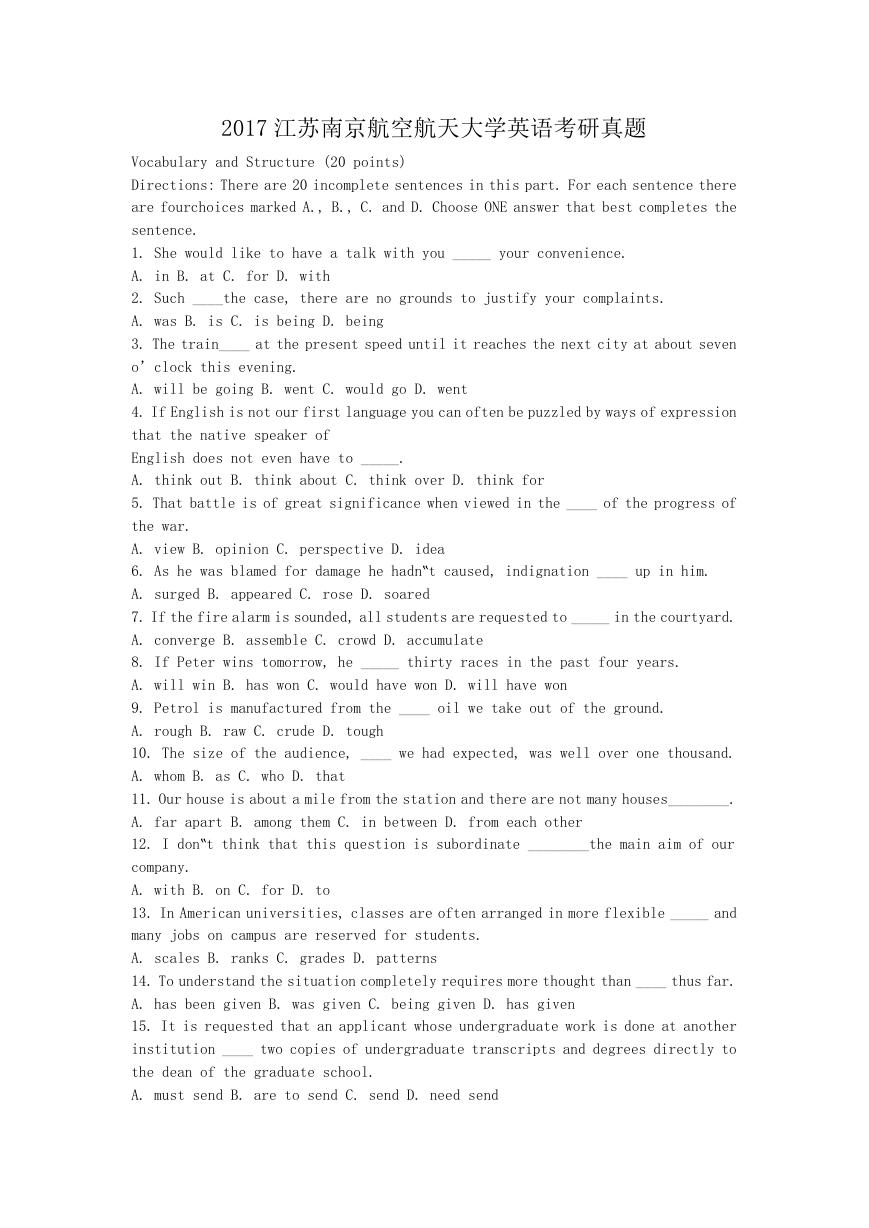
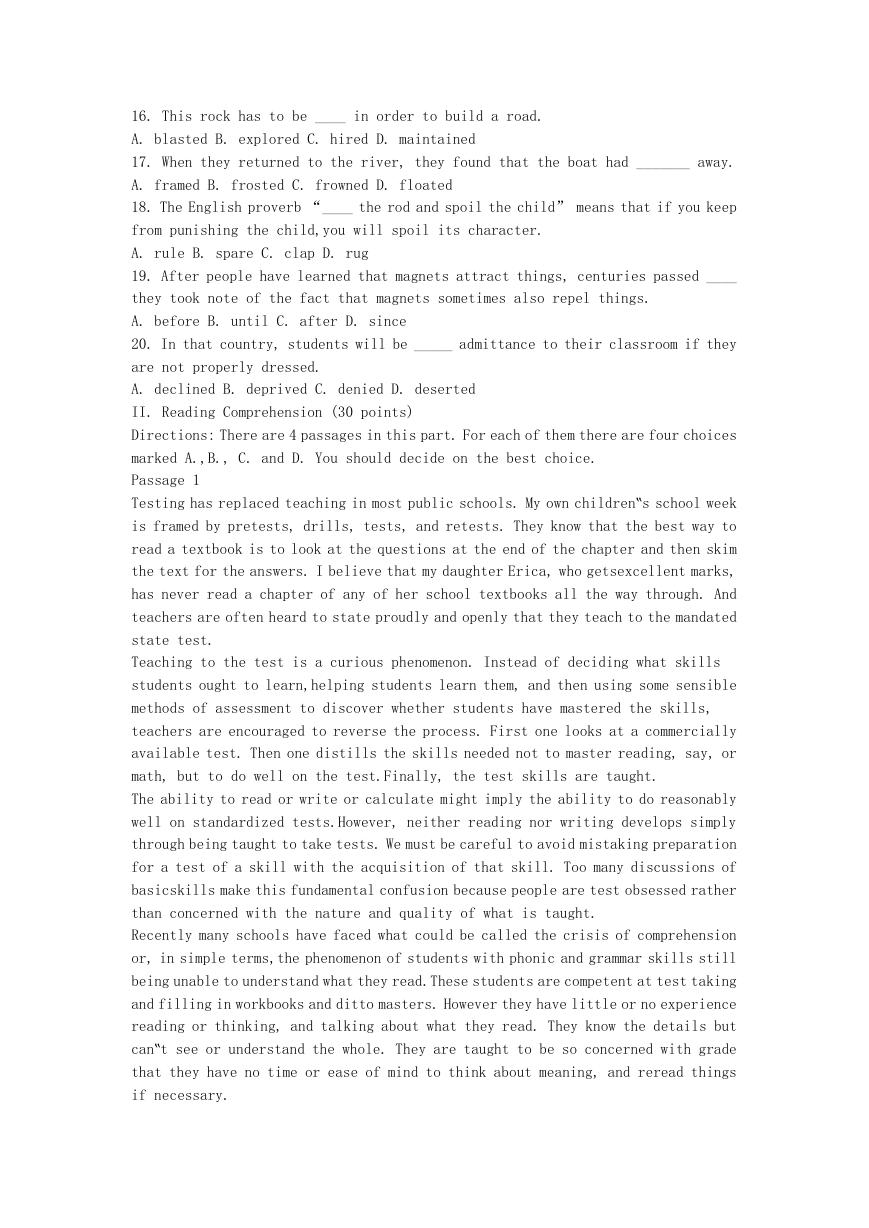
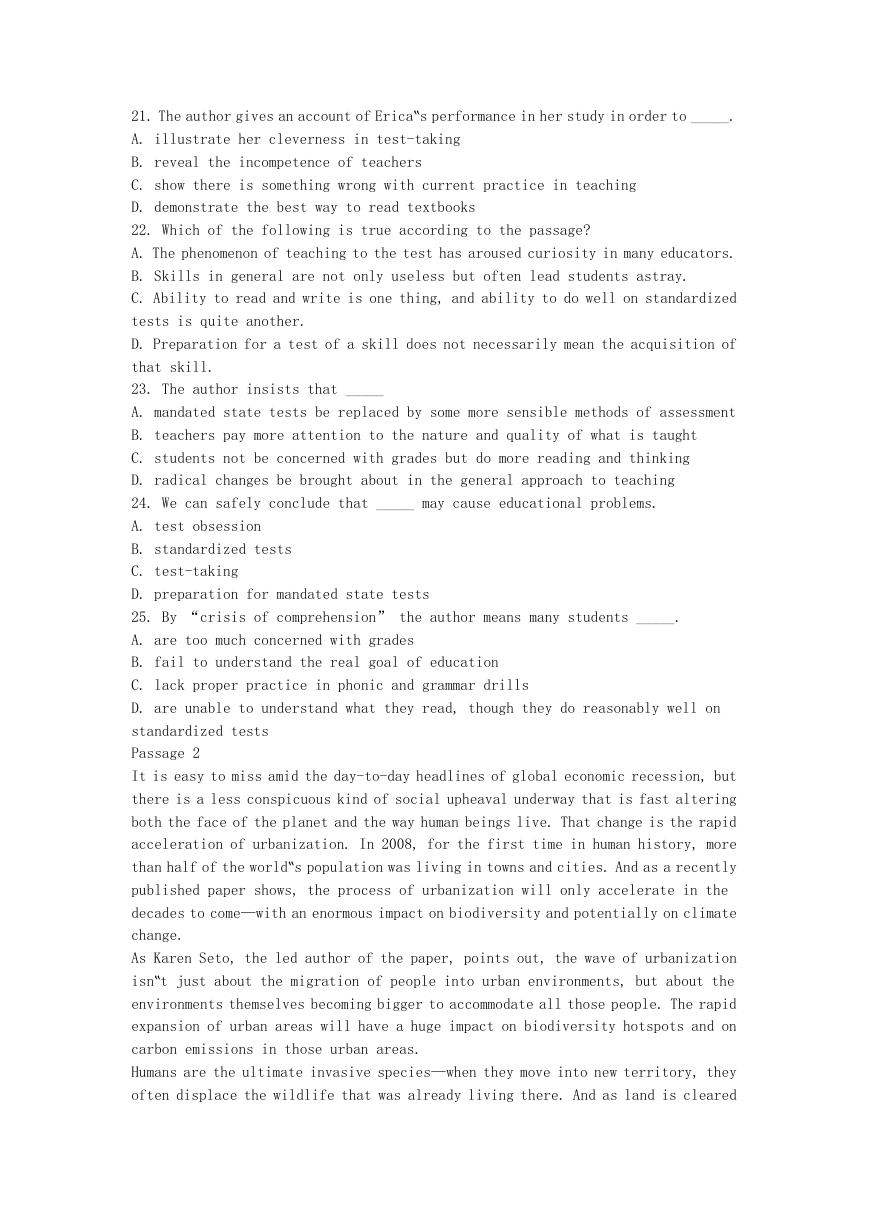
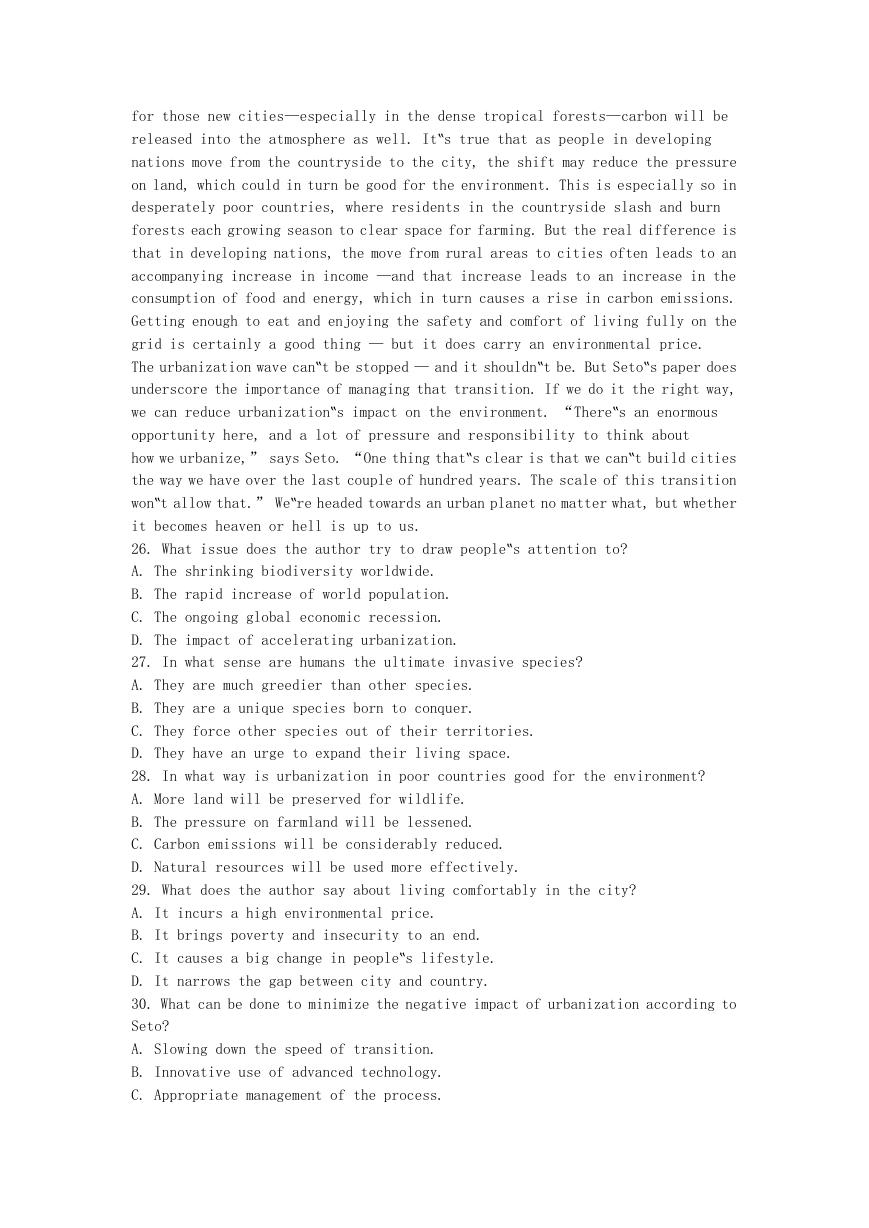
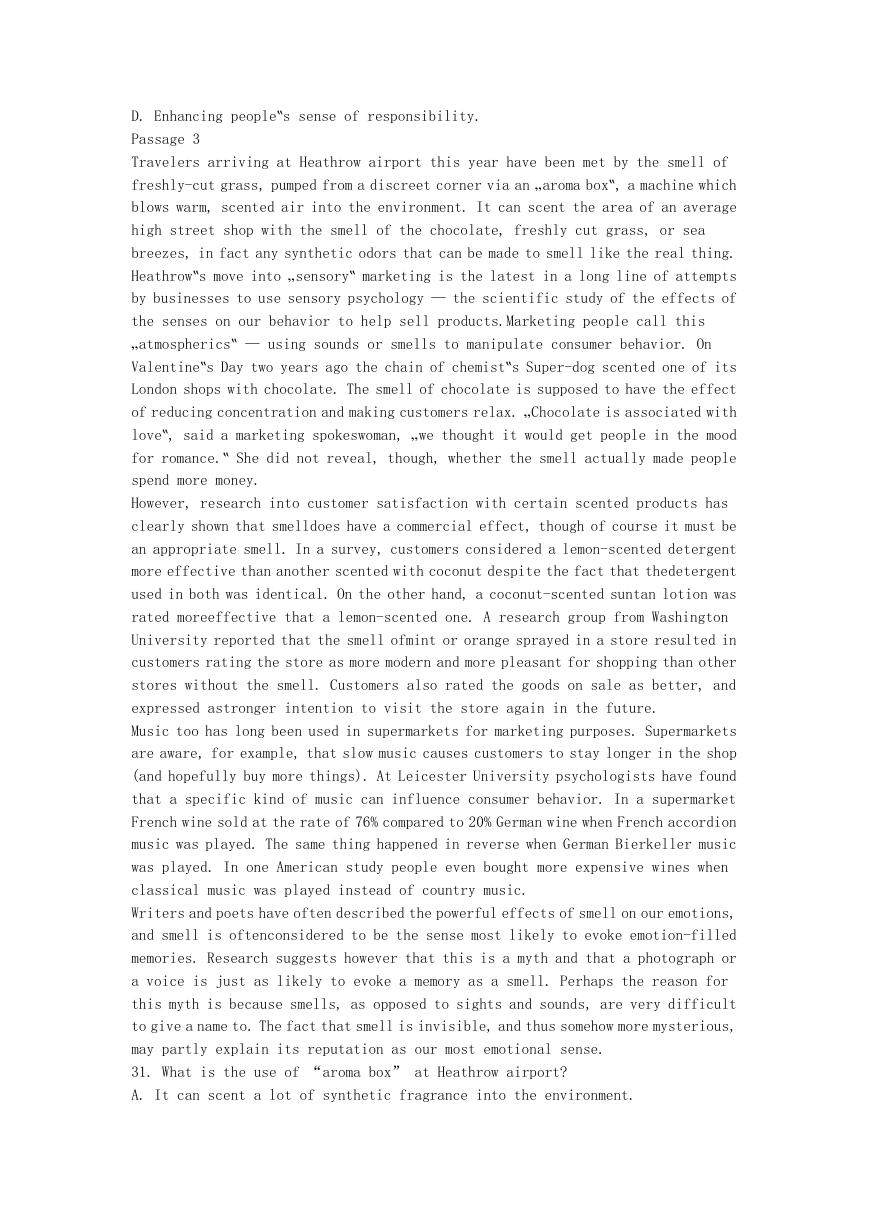
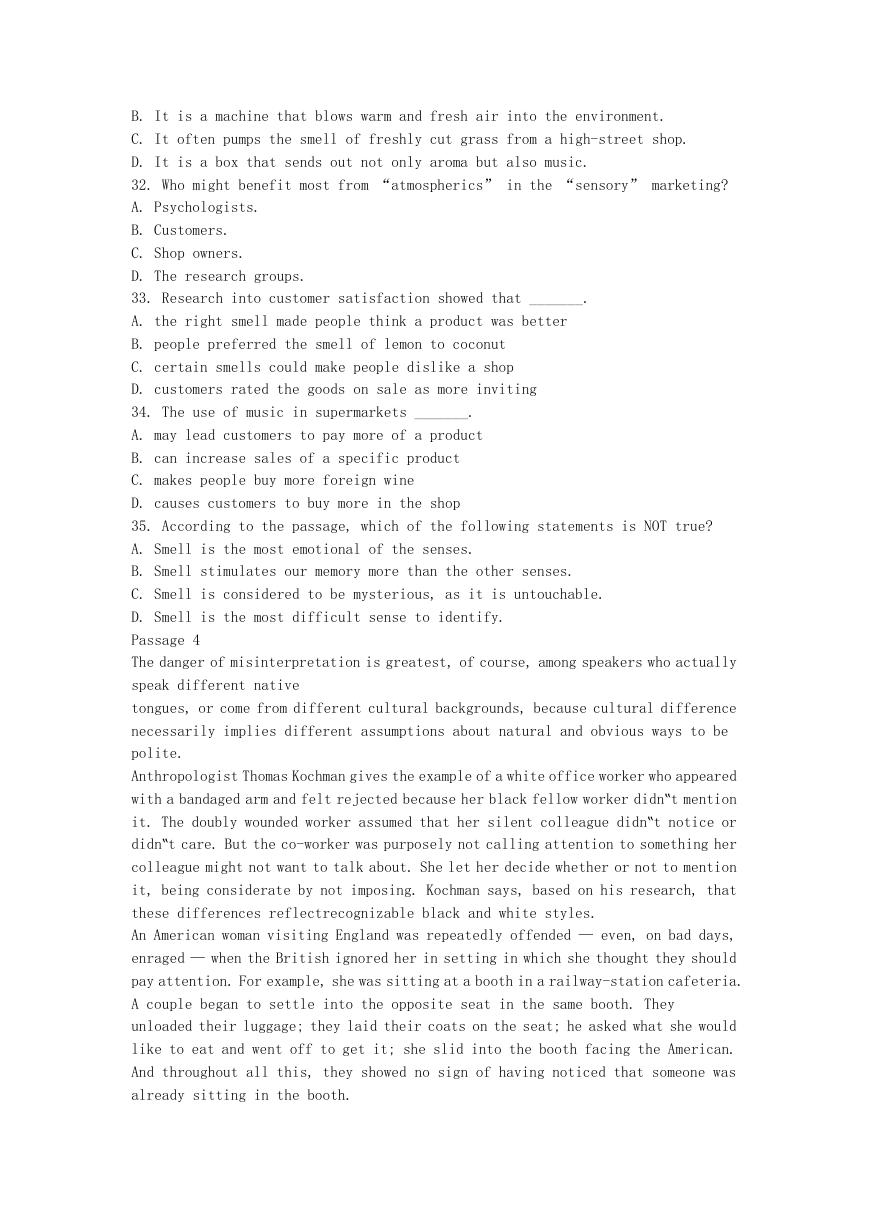
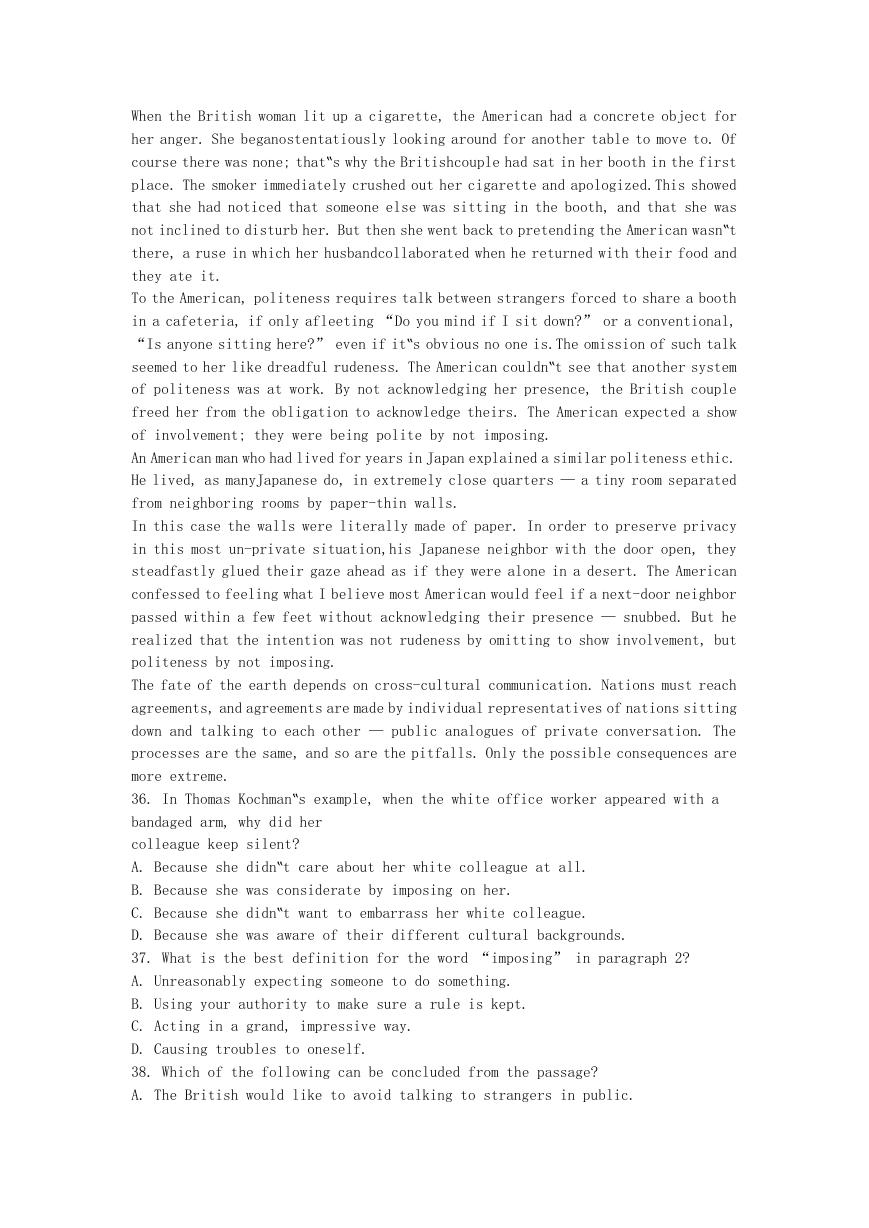
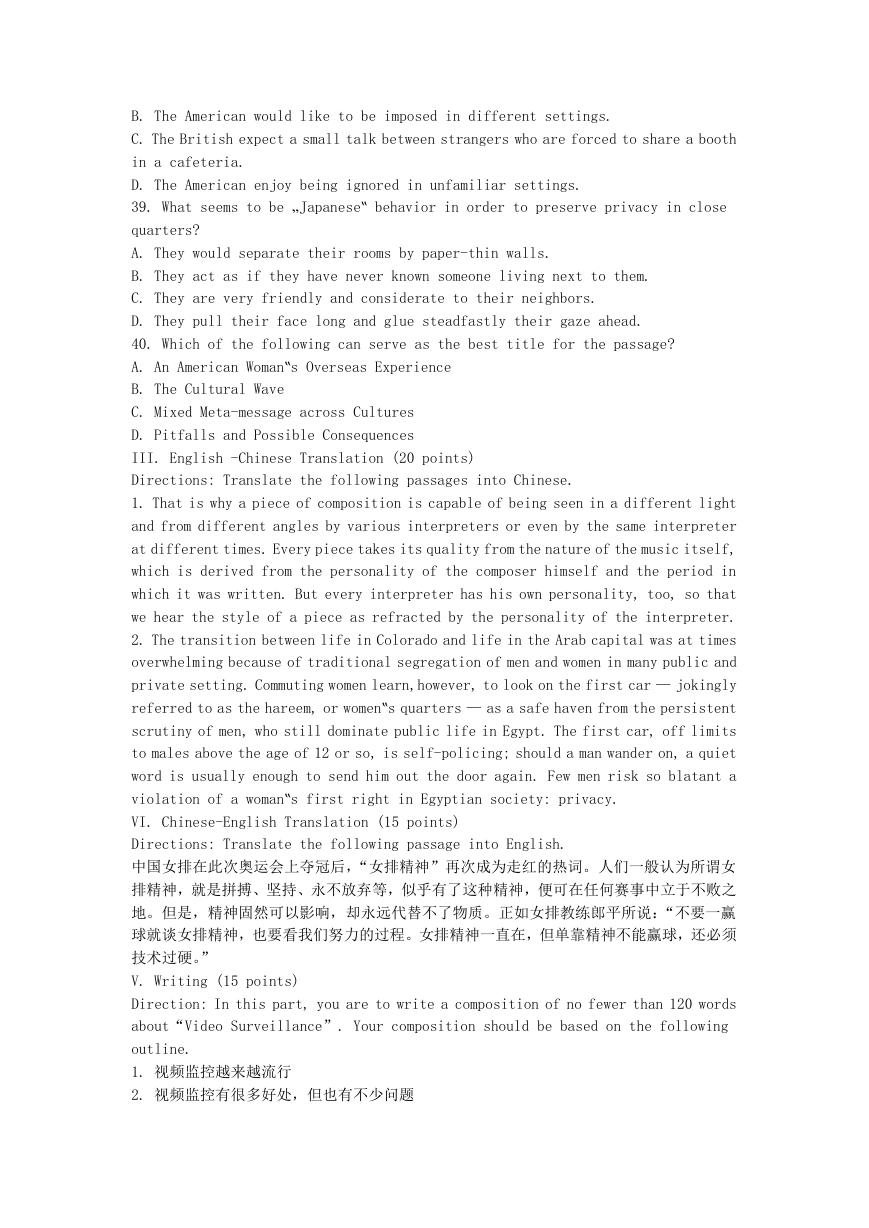








 2023年江西萍乡中考道德与法治真题及答案.doc
2023年江西萍乡中考道德与法治真题及答案.doc 2012年重庆南川中考生物真题及答案.doc
2012年重庆南川中考生物真题及答案.doc 2013年江西师范大学地理学综合及文艺理论基础考研真题.doc
2013年江西师范大学地理学综合及文艺理论基础考研真题.doc 2020年四川甘孜小升初语文真题及答案I卷.doc
2020年四川甘孜小升初语文真题及答案I卷.doc 2020年注册岩土工程师专业基础考试真题及答案.doc
2020年注册岩土工程师专业基础考试真题及答案.doc 2023-2024学年福建省厦门市九年级上学期数学月考试题及答案.doc
2023-2024学年福建省厦门市九年级上学期数学月考试题及答案.doc 2021-2022学年辽宁省沈阳市大东区九年级上学期语文期末试题及答案.doc
2021-2022学年辽宁省沈阳市大东区九年级上学期语文期末试题及答案.doc 2022-2023学年北京东城区初三第一学期物理期末试卷及答案.doc
2022-2023学年北京东城区初三第一学期物理期末试卷及答案.doc 2018上半年江西教师资格初中地理学科知识与教学能力真题及答案.doc
2018上半年江西教师资格初中地理学科知识与教学能力真题及答案.doc 2012年河北国家公务员申论考试真题及答案-省级.doc
2012年河北国家公务员申论考试真题及答案-省级.doc 2020-2021学年江苏省扬州市江都区邵樊片九年级上学期数学第一次质量检测试题及答案.doc
2020-2021学年江苏省扬州市江都区邵樊片九年级上学期数学第一次质量检测试题及答案.doc 2022下半年黑龙江教师资格证中学综合素质真题及答案.doc
2022下半年黑龙江教师资格证中学综合素质真题及答案.doc